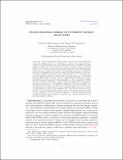Files in this item
Spatio-temporal models of synthetic genetic oscillators
Item metadata
| dc.contributor.author | Macnamara, Cicely K. | |
| dc.contributor.author | Chaplain, Mark A. J. | |
| dc.date.accessioned | 2017-10-01T23:32:10Z | |
| dc.date.available | 2017-10-01T23:32:10Z | |
| dc.date.issued | 2017-02 | |
| dc.identifier | 242017463 | |
| dc.identifier | 05fe7dc2-ecf5-410a-84d5-4baf2de2ae1e | |
| dc.identifier | 85002776531 | |
| dc.identifier | 000387005500017 | |
| dc.identifier.citation | Macnamara , C K & Chaplain , M A J 2017 , ' Spatio-temporal models of synthetic genetic oscillators ' , Mathematical Biosciences and Engineering , vol. 14 , no. 1 , pp. 249-262 . https://doi.org/10.3934/mbe.2017016 | en |
| dc.identifier.issn | 1547-1063 | |
| dc.identifier.other | ORCID: /0000-0003-4961-6052/work/28355711 | |
| dc.identifier.other | ORCID: /0000-0001-5727-2160/work/55378861 | |
| dc.identifier.uri | https://hdl.handle.net/10023/11774 | |
| dc.description.abstract | Signal transduction pathways play a major role in many important aspects of cellular function e.g. cell division, apoptosis. One important class of signal transduction pathways is gene regulatory networks (GRNs). In many GRNs, proteins bind to gene sites in the nucleus thereby altering the transcription rate. Such proteins are known as transcription factors. If the binding reduces the transcription rate there is a negative feedback leading to oscillatory behaviour in mRNA and protein levels, both spatially (e.g. by observing fluorescently labelled molecules in single cells) and temporally (e.g. by observing protein/mRNA levels over time). Recent computational modelling has demonstrated that spatial movement of the molecules is a vital component of GRNs and may cause the oscillations. These numerical findings have subsequently been proved rigorously i.e. the diffusion coefficient of the protein/mRNA acts as a bifurcation parameter and gives rise to a Hopf bifurcation. In this paper we first present a model of the canonical GRN (the Hes1 protein) and show the effect of varying the spatial location of gene and protein production sites on the oscillations. We then extend the approach to examine spatio-temporal models of synthetic gene regulatory networks e.g. n-gene repressilators and activator-repressor systems. | |
| dc.format.extent | 14 | |
| dc.format.extent | 2921379 | |
| dc.language.iso | eng | |
| dc.relation.ispartof | Mathematical Biosciences and Engineering | en |
| dc.subject | Gene regulatory networks (GRN) | en |
| dc.subject | Diffusion-driven oscillations | en |
| dc.subject | Synthetic gene networks | en |
| dc.subject | Repressilators | en |
| dc.subject | Positive-negative feedback | en |
| dc.subject | QA Mathematics | en |
| dc.subject | QH301 Biology | en |
| dc.subject | T-NDAS | en |
| dc.subject.lcc | QA | en |
| dc.subject.lcc | QH301 | en |
| dc.title | Spatio-temporal models of synthetic genetic oscillators | en |
| dc.type | Journal article | en |
| dc.contributor.institution | University of St Andrews. Applied Mathematics | en |
| dc.identifier.doi | https://doi.org/10.3934/mbe.2017016 | |
| dc.description.status | Peer reviewed | en |
| dc.date.embargoedUntil | 2017-10-01 |
This item appears in the following Collection(s)
Items in the St Andrews Research Repository are protected by copyright, with all rights reserved, unless otherwise indicated.

